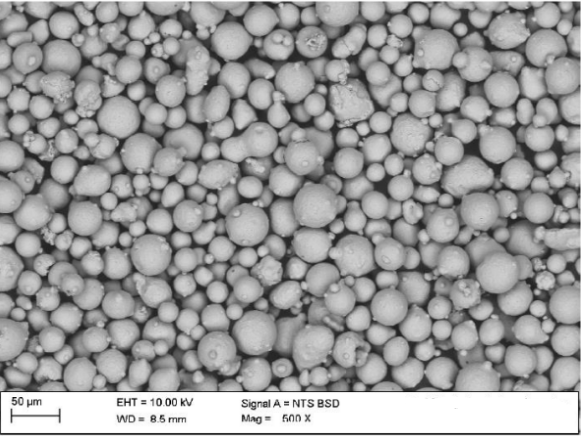Enhanced TDS
Knowde-enriched technical product data sheet
Identification & Functionality
- Technologies
- Product Families
- Chemical Composition
Depending on the use conditions, stricter analysis limits apply to certain alloy elements. The purpose of this limitation is to optimize the microstructure and mechanical properties with regard to the intended use. For example, alloys with carbon and niobium concentrations near the upper limit according to ASTM are best suited for high-temperature applications, while lesser carbon and niobium concentrations result in material microstructures that conform better to the requirements of corrosive use conditions.
Features & Benefits
- Labeling Claims
- Base Chemicals Features
- Features
VDM® Powder 718 is characterized by:
- Spherical particles with low level of satellites
- High purity and reproducibility level
- Low oxygen content
- Small amount of porosity
- Good flowability
- High apparent and tap density
Applications & Uses
- Markets
- Applications
- Applicable Processes
- Base Chemicals End Uses
- Applications
VDM® Powder 718 can be used for a wide range of processes:
- Laser based additive manufacturing
- Electron beam based additive manufacturing
- Coatings
- Direct energy deposition
- Overlay welding
- Cold and hot isostatic pressing (CIP / HIP)
VDM® Powder 718 can be used for many demanding applications. Originally, it was developed and used for static and rotating components in aircraft turbines such as housings, mounting elements and turbine disks. The material can also be used for static and rotating components in stationary gas turbines, rocket drives and spacecraft, motor vehicle turbo chargers, high-strength screws, springs and mounting elements, and for heat-resistant tools in for-geries, extruders and separating shearers.
The variant VDM® Powder 718 CTP, which is designed specifically for the requirements of the oil and gas industry, is increasingly being used in drilling equipment and pump shafts. (For more information see data sheet no. 2001 VDM® Powder 718 CTP)
Properties
- Physical Form
- Chemical Properties
Value Units Test Method / Conditions Aluminum Content 0.2 - 0.8 wt. % - Boron Content max. 0.006 wt. % - Bismuth Content max. 0.00003 wt. % AMS 5662 Carbon Content max. 0.08 wt. % - Cobalt Content max. 1 wt. % - Chromium Content 17 - 21 wt. % - Copper Content max. 0.3 wt. % - Manganese Content max. 0.35 wt. % - Molybdenum Content 2.8 - 3.3 wt. % - Nitrogen Content max. 0.02 wt. % - Niobium Content 4.75 - 5.5 wt. % - Nickel Content 50 - 55 wt. % - Oxygen Content max. 0.03 wt. % - Phosphorus Content max. 0.015 wt. % - Lead Content max. 0.0005 wt. % AMS 5662 Sulfur Content max. 0.015 wt. % - Selenium Content max. 0.0003 wt. % AMS 5662 Silicon Content max. 0.35 wt. % - Titanium Content 0.65 - 1.15 wt. % - - Physical Properties
Value Units Test Method / Conditions Density (20°C) max. 8.26 g/cm³ - Melting Range 1,257 - 1,342 °C - - Microstructural Properties
VDM® Powder 718 is well known alloy for applications in high demanding industries such as in the aerospace, oil & gas and chemical process industries due to its unique mechanical properties and good processing characteristics, especially its workability (weldability). VDM® Powder 718 has an austenitic microstructure, however in bulk condition different phases can occur. VDM® Powder 718 is a complex alloy system where mechanical properties and microstructure stability at high temperatures depend on the amount and morphology of y’’-Ni3Nb, y’-Ni3Al and δ-Ni3Nb phases. The adjustment of microstructure to the relevant application needs and the necessary amount of strengthening precipitations can be achieved by applying different heat treatments.

- Physical Properties
Particle size distribution
μmFlowability Apparent density Tap density ASTM B213 ASTM B964 ASTM B212 ASTM B417 ASTM B527 15-53 Y Y Y Y Y 20-63 Y Y Y Y Y 53-150 Y Y Y Y Y
Y - The test can be performedStandard inspection certificate contains particle size distribution and chemical analysis.
Regulatory & Compliance
- Designations and Standards
Standard Material designation
EN 2.4668 - NiCr19Fe19Nb5Mo3
ISO NiCr19Nb5Mo3 UNS N07718 AFNOR NC19FeNb ASTM F3055*, B637* SAE AMS 5662* *only chemical analysis and partial heat treatments
Packaging & Availability
- Packaging Type
- Availability
According to the requirements of the powder based processes, VDM® Powder 718 is available in a wide range of particle fractions from 15 to 250 μm. The typical powder atomization yield ranges from 0,1 to 300 μm. After atomization, the powder is sieved and air classified according to customers specifications. All production and handling operations are carried out under protective atmosphere (argon).
Standard particle fractions
Particle size distribution
[μm]Fine particle D10
[μm]
(tolerance +/-5 μm)D50
[μm]
(tolerance +/-5 μm)15-53 <15 μm max. 3% 22 35 20-63 <18 μm max. 3% 25 40 The determination of the PSD is done by laser diffraction according to ASTM B822.
- Packaging
The whole production and packaging process at VDM Metals is under argon and the powder has no contact to atmos-phere. The standard powder is packed in plastic bags (5kg/10kg/20kg) under argon inside of sealed plastic drums (6l).
Storage & Handling
- Handling
- Please note that powder transportation may result in segregation of particle sizes.
- Do not open the container in humid environment.
- After contact with air the powder has limited storability.
- Humidity can influence the powder properties.